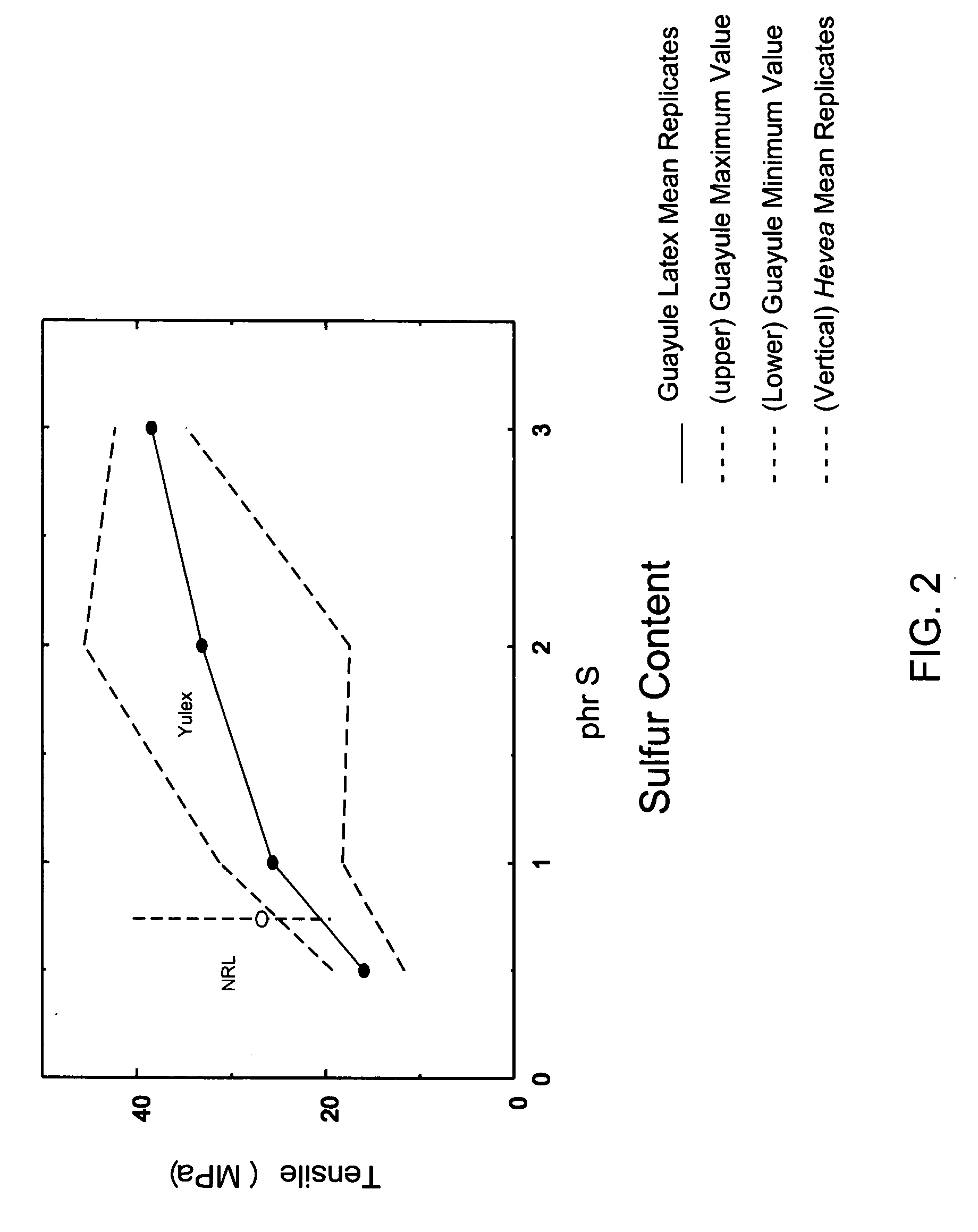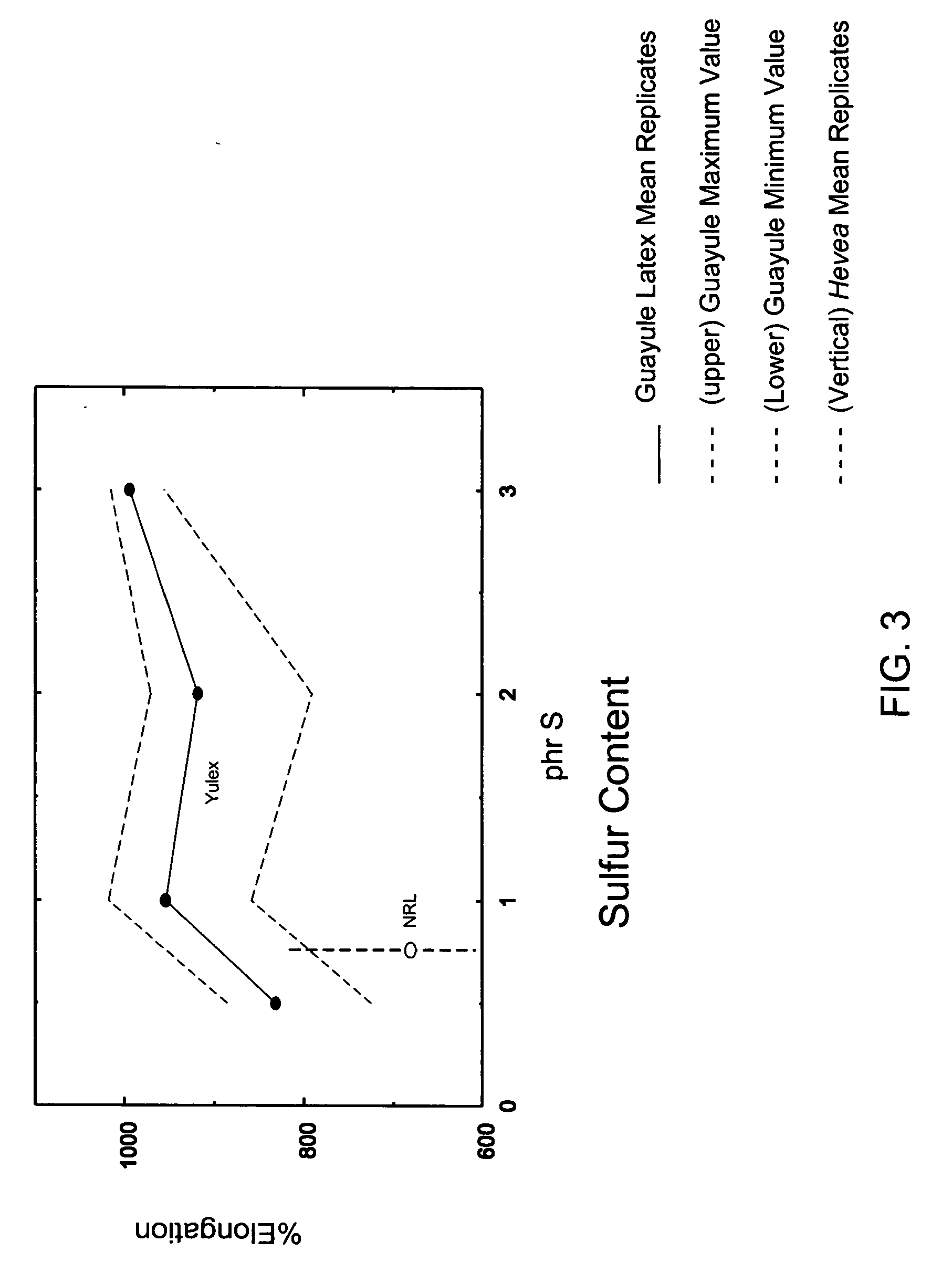Non-synthetic low-protein rubber latex product and method of testing
a non-synthetic, low-protein technology, applied in the field of natural latex products, can solve the problems of limiting the availability of materials, and affecting the wide use of natural rubber
- Summary
- Abstract
- Description
- Claims
- Application Information
AI Technical Summary
Problems solved by technology
Method used
Image
Examples
example 1
Dry Films
[0041] Air-free, dry, homogeneous films are prepared from concentrated non-Hevea lattices, such as guayule. A mold is constructed by cementing rigid plastic strips 6 millimeters (mm) wide and 1.5 mm thick on a flat glass plate to form a cavity surface that is preferably from 125 to 150 mm square. Dry films 1 mm thick will result when the mold is filled with latex at 62% total solids content (TSC) and about 0.7 mm can be produced with 48% TSC latex. Tests are then performed to compare non-Hevea and Hevea latex films according to standard techniques, pursuant to ASTM D1418 and D1566 Standards.
[0042] In one embodiment of film preparation, the mold is formed by cementing plastic strips to a glass plate with epoxide resin adhesive or polyvinyl acetate dissolved in methyl ethyl ketone. A wood or stainless steel straightedge is used to scrape the surface of latex in the mold free of air bubbles. Thin transparent cellulosic film sheets are used to cover and protect the dry rubber...
example 2
Physical Property Comparison of Guayule Latex and Hevea Latex Glove Films
[0062] Guayule latex glove films are made using the following protocol. A glove former is preheated to 75° C. and dipped in a coagulant comprised of 17% CaNO3, 4% CaCO3, 0.2% surfactants at 45° C. with no dwell time. Coagulant is dried for one minute at 75° C. The former is then dipped into the compounded latex (33% TSC, room temp.) with a ten count dwell time to form a film. The film-coated formers are dried for six minutes at 75° C., bead rolled to form a cuff, and then leached for two minutes at 50° C. The films are then cured for fifteen minutes at 110° C., removed from the former and chlorinated. Physical composition and content is then measured for guayule latex glove films, made as described above. Guayule latex films are measured in comparison to commercially available chlorinated Hevea latex glove films, using standard techniques to measure swell, modulus, tensile strength and elongation to break. Mec...
example 3
Method of Determining Properties of a Guayule Latex Product
[0073] In another embodiment, the method is a method of determining the properties of a non-synthetic, low-allergenic, non-Hevea latex product. In this method, the physical or chemical properties of low-allergenicity of a non-synthetic latex product processed from a natural non-Hevea rubber source are determined, based on the presence of proteins and other physical and chemical properties. More specifically, this method is used to measure natural non-Hevea rubber processed and concentrated either by centrifugation or a combination of centrifugation and creaming. In various embodiments the method disclosed herein is used to monitor physical properties and composition of the latex product at one or more stages in the production, storage, transfer, or manufacturing process.
[0074] Generally, extracted latex for industrial or medical uses, including those of the present disclosure, is tested for conformity to the standard speci...
PUM
| Property | Measurement | Unit |
|---|---|---|
| dry weight | aaaaa | aaaaa |
| specific gravity | aaaaa | aaaaa |
| dry weight | aaaaa | aaaaa |
Abstract
Description
Claims
Application Information
 Login to View More
Login to View More - R&D
- Intellectual Property
- Life Sciences
- Materials
- Tech Scout
- Unparalleled Data Quality
- Higher Quality Content
- 60% Fewer Hallucinations
Browse by: Latest US Patents, China's latest patents, Technical Efficacy Thesaurus, Application Domain, Technology Topic, Popular Technical Reports.
© 2025 PatSnap. All rights reserved.Legal|Privacy policy|Modern Slavery Act Transparency Statement|Sitemap|About US| Contact US: help@patsnap.com



